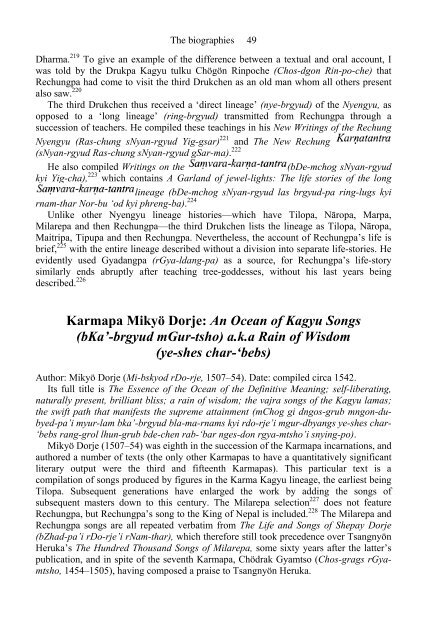The Biographies of Rechungpa: The Evolution of a Tibetan ...
The Biographies of Rechungpa: The Evolution of a Tibetan ...
The Biographies of Rechungpa: The Evolution of a Tibetan ...
You also want an ePaper? Increase the reach of your titles
YUMPU automatically turns print PDFs into web optimized ePapers that Google loves.
<strong>The</strong> biographies 49<br />
Dharma. 219 To give an example <strong>of</strong> the difference between a textual and oral account, I<br />
was told by the Drukpa Kagyu tulku Chögön Rinpoche (Chos-dgon Rin-po-che) that<br />
<strong>Rechungpa</strong> had come to visit the third Drukchen as an old man whom all others present<br />
also saw. 220<br />
<strong>The</strong> third Drukchen thus received a ‘direct lineage’ (nye-brgyud) <strong>of</strong> the Nyengyu, as<br />
opposed to a ‘long lineage’ (ring-brgyud) transmitted from <strong>Rechungpa</strong> through a<br />
succession <strong>of</strong> teachers. He compiled these teachings in his New Writings <strong>of</strong> the Rechung<br />
Nyengyu (Ras-chung sNyan-rgyud Yig-gsar) 221 and <strong>The</strong> New Rechung<br />
(sNyan-rgyud Ras-chung sNyan-rgyud gSar-ma). 222<br />
He also compiled Writings on the (bDe-mchog sNyan-rgyud<br />
kyi Yig-cha), 223 which contains A Garland <strong>of</strong> jewel-lights: <strong>The</strong> life stories <strong>of</strong> the long<br />
lineage (bDe-mchog sNyan-rgyud las brgyud-pa ring-lugs kyi<br />
rnam-thar Nor-bu ‘od kyi phreng-ba). 224<br />
Unlike other Nyengyu lineage histories—which have Tilopa, Nāropa, Marpa,<br />
Milarepa and then <strong>Rechungpa</strong>—the third Drukchen lists the lineage as Tilopa, Nāropa,<br />
Maitripa, Tipupa and then <strong>Rechungpa</strong>. Nevertheless, the account <strong>of</strong> <strong>Rechungpa</strong>’s life is<br />
brief, 225 with the entire lineage described without a division into separate life-stories. He<br />
evidently used Gyadangpa (rGya-ldang-pa) as a source, for <strong>Rechungpa</strong>’s life-story<br />
similarly ends abruptly after teaching tree-goddesses, without his last years being<br />
described. 226<br />
Karmapa Mikyö Dorje: An Ocean <strong>of</strong> Kagyu Songs<br />
(bKa’-brgyud mGur-tsho) a.k.a Rain <strong>of</strong> Wisdom<br />
(ye-shes char-‘bebs)<br />
Author: Mikyö Dorje (Mi-bskyod rDo-rje, 1507–54). Date: compiled circa 1542.<br />
Its full title is <strong>The</strong> Essence <strong>of</strong> the Ocean <strong>of</strong> the Definitive Meaning; self-liberating,<br />
naturally present, brilliant bliss; a rain <strong>of</strong> wisdom; the vajra songs <strong>of</strong> the Kagyu lamas;<br />
the swift path that manifests the supreme attainment (mChog gi dngos-grub mngon-dubyed-pa’i<br />
myur-lam bka’-brgyud bla-ma-rnams kyi rdo-rje’i mgur-dbyangs ye-shes char-<br />
‘bebs rang-grol lhun-grub bde-chen rab-‘bar nges-don rgya-mtsho’i snying-po).<br />
Mikyö Dorje (1507–54) was eighth in the succession <strong>of</strong> the Karmapa incarnations, and<br />
authored a number <strong>of</strong> texts (the only other Karmapas to have a quantitatively significant<br />
literary output were the third and fifteenth Karmapas). This particular text is a<br />
compilation <strong>of</strong> songs produced by figures in the Karma Kagyu lineage, the earliest being<br />
Tilopa. Subsequent generations have enlarged the work by adding the songs <strong>of</strong><br />
subsequent masters down to this century. <strong>The</strong> Milarepa selection 227 does not feature<br />
<strong>Rechungpa</strong>, but <strong>Rechungpa</strong>’s song to the King <strong>of</strong> Nepal is included. 228 <strong>The</strong> Milarepa and<br />
<strong>Rechungpa</strong> songs are all repeated verbatim from <strong>The</strong> Life and Songs <strong>of</strong> Shepay Dorje<br />
(bZhad-pa’i rDo-rje’i rNam-thar), which therefore still took precedence over Tsangnyön<br />
Heruka’s <strong>The</strong> Hundred Thousand Songs <strong>of</strong> Milarepa, some sixty years after the latter’s<br />
publication, and in spite <strong>of</strong> the seventh Karmapa, Chödrak Gyamtso (Chos-grags rGyamtsho,<br />
1454–1505), having composed a praise to Tsangnyön Heruka.











